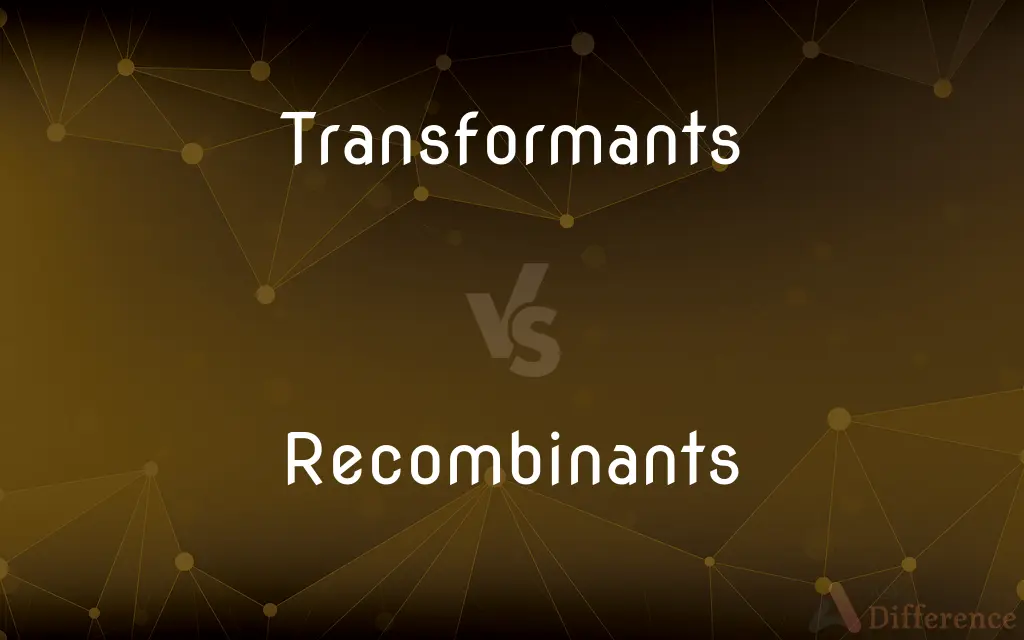Transformants vs. Recombinants — What's the Difference?
By Tayyaba Rehman — Published on January 6, 2024
Transformants are cells that have taken up foreign DNA. Recombinants are cells or organisms with recombined, altered genetic material.

Difference Between Transformants and Recombinants
Table of Contents
ADVERTISEMENT
Key Differences
Transformants are cells that have undergone transformation, a process where they incorporate foreign DNA into their own genetic material. This process is often used in molecular biology to introduce new genes into a cell. Recombinants, on the other hand, are the result of recombination, where genetic material is mixed or rearranged to create a new genetic combination, often involving the merging of DNA from different sources.
In transformants, the foreign DNA may or may not integrate into the host genome and can be transient or stable. This process is crucial in cloning and genetic modification experiments. Recombinants are typically the product of deliberate genetic engineering where DNA sequences from different organisms are combined, as seen in biotechnology and gene therapy.
The creation of transformants is a tool in studying gene function and protein expression, as it allows for the introduction of new genes into a cell. The production of recombinants is essential in creating genetically modified organisms (GMOs), where new traits are introduced through recombined DNA.
Transformants can be identified through methods like antibiotic resistance or reporter genes, indicating successful DNA uptake. In contrast, recombinants are often identified by the presence of specific genetic sequences or the expression of new traits resulting from the recombined DNA.
The significance of transformants lies in their ability to help understand gene function and regulation. Recombinants are significant in the development of new therapies, vaccines, and genetically modified crops, showcasing the practical applications of recombined genetic material.
ADVERTISEMENT
Comparison Chart
Definition
Cells that have taken up foreign DNA.
Cells or organisms with recombined, altered genetic material.
Process
Transformation (absorption of DNA).
Recombination (mixing or rearranging DNA).
Purpose
Studying gene function, protein expression.
Creating GMOs, gene therapy, new traits introduction.
Identification
Through markers like antibiotic resistance.
By specific genetic sequences or new trait expression.
Significance
Understanding gene regulation, cloning.
Developing new therapies, vaccines, GMO crops.
Compare with Definitions
Transformants
Can carry transient or stable foreign DNA.
Transient transformants expressed the foreign gene temporarily.
Recombinants
Essential for creating genetically modified organisms.
Recombinant crops have improved resistance to pests and diseases.
Transformants
Result of genetic transformation in a laboratory.
Transformants were used to study the function of the inserted gene.
Recombinants
Organisms with recombined genetic material.
Recombinant DNA technology produced bacteria that synthesize human insulin.
Transformants
Cells that have absorbed foreign DNA.
The bacterial transformants were resistant to antibiotics, indicating successful transformation.
Recombinants
Identified by new genetic sequences or traits.
The recombinants were identified by their unique genetic markers.
Transformants
Indicate successful uptake of foreign DNA.
The transformants showed fluorescence, a sign of successful DNA incorporation.
Recombinants
Result from deliberate genetic engineering.
The recombinants exhibited traits from both parent species.
Transformants
Used in cloning and genetic modification.
Yeast transformants were created to produce insulin.
Recombinants
Used in gene therapy and biotechnology.
Recombinant viruses are being developed for targeted gene therapy.
Transformants
Plural of transformant
Recombinants
An organism, cell, or virus in which genetic recombination has taken place.
Recombinants
Material produced by genetic engineering.
Recombinants
Formed by or showing recombination
A recombinant chromosome.
Recombinants
Of or relating to recombinant DNA
Recombinant fragments.
Recombinant technology.
Recombinants
Plural of recombinant
Common Curiosities
What defines recombinants?
Cells or organisms with genetically recombined material.
How are transformants created?
By introducing foreign DNA into cells, often using vectors.
What role do transformants play in biotechnology?
Crucial for cloning, gene function analysis, and protein production.
Can transformants lead to stable genetic changes?
Yes, if the foreign DNA integrates into the host genome.
Are recombinants natural or artificial?
They are usually artificially created through genetic engineering.
What are transformants in genetics?
Cells that have incorporated foreign DNA through transformation.
Is the foreign DNA in transformants always from the same species?
No, it can be from different species, enabling cross-species gene study.
What is the purpose of creating recombinants?
To combine DNA from different sources for new traits or therapies.
Can transformants be used in gene therapy?
Yes, particularly for studying gene function and regulation.
How are recombinants identified?
Through specific genetic markers or the expression of new traits.
What makes transformants important in research?
They allow scientists to study the effects of specific genes.
Can recombinants express traits from multiple organisms?
Yes, they can express combined traits from different genetic sources.
What is the key difference between transformants and recombinants?
Transformants result from the absorption of foreign DNA, while recombinants involve the deliberate rearrangement or combination of genetic material.
Are recombinants used in agriculture?
Yes, particularly in developing GMO crops with improved traits.
How do recombinants contribute to medicine?
They are used in developing new vaccines and gene therapies.
Share Your Discovery

Previous Comparison
DTE vs. DCE
Next Comparison
Tracheids vs. VesselsAuthor Spotlight
Written by
Tayyaba RehmanTayyaba Rehman is a distinguished writer, currently serving as a primary contributor to askdifference.com. As a researcher in semantics and etymology, Tayyaba's passion for the complexity of languages and their distinctions has found a perfect home on the platform. Tayyaba delves into the intricacies of language, distinguishing between commonly confused words and phrases, thereby providing clarity for readers worldwide.
















































